the place where Paleontology and Paleoanthropology meets Philately
Yugoslavia (original name Jugoslavia)
Reconstructions and fossils of prehistoric animals on stamps and postmarks of Yugoslavia.
| << previous country | back to index | next country >> |
Contents:
- Country overview
- Philately of Yugoslavia
- Official stamps of Yugoslavia related to Paleontology
- Other stamps of Yugoslavia to consider
- Commemorative covers of Yugoslavia related to Paleontology and Paleoanthropology
- Postmarks and meter franking of Yugoslavia related to Paleontology
- References
- Acknowledgements
Yugoslavia, once spelled and called "Jugoslavia", was a country in Southeast Europe during most of the 20th century. It came into existence after World War I in 1918 under the name of the Kingdom of Serbs, Croats and Slovenes by the merger of the provisional State of Slovenes, Croats and Serbs. Yugoslavia gained international recognition on 13 July 1922 at the Conference of Ambassadors in Paris. The country was named after the South Slavic peoples and constituted their first union, following centuries in which the territories had been part of the Ottoman Empire and Austria-Hungary.
The breakup of Yugoslavia occurred as a result of a series of political upheavals and conflicts during the early 1990s. After a period of political crisis in 1980s, constituent republics of the Socialist Federal Republic of Yugoslavia split apart into Slovenia, Croatia, Bosnia and Herzegovina, Serbia, Montenegro and Macedonia during 1991 and 1992. [R1]
The story of the postage stamps and postal history of Yugoslavia officially begins with the formation of the Kingdom of Serbs, Croats and Slovenes on 1 December 1918.
Prior to the formation of the Kingdom, each of the constituent territories had their own postal systems and history. The first stamps intended for use throughout the kingdom were issued 16 January 1921.
The name of the state was changed to "Kingdom of Yugoslavia" on 3 October 1929. In 1931, a new series was the first to be inscribed "JUGOSLAVIA". The old series of 1926 was also overprinted with the new name.
During entire history of the country, prehistoric animals appeared on stamps only once in 1985.
[R2]
Official stamps of Yugoslavia related to Paleoanthropology: fossils and reconstruction of prehistoric animals
| 04.02.1985 "Fossils" | ||
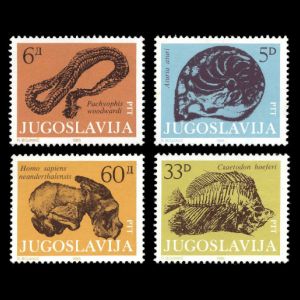 |
|
|
Other stamps of Yugoslavia to consider: contributors to Paleontology
| 28.05.1979 "100th anniversary of Milutin Milankovic" [A1] | 10.09.1989 "Famous persons: Janez Vajkard Valvasor" [A2] | 15.02.1996 "100th anniversary of the Natural History Museum in Belgrade" [A3] |
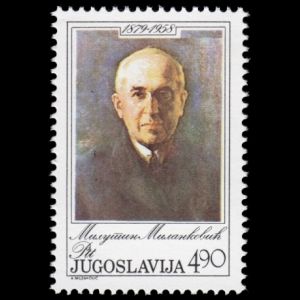 |
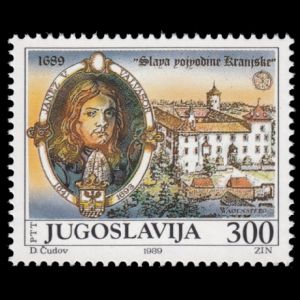 |
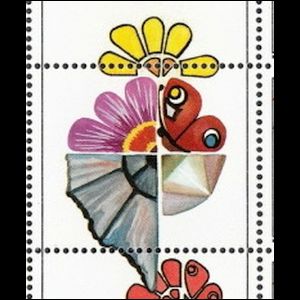 |
Notes:
[A1] Milutin Milanković (28 May 1879 – 12 December 1958) was a Serbian mathematician, astronomer, climatologist, geophysicist, civil engineer and popularizer of science.
Milanković gave two fundamental contributions to global science. The first contribution is the "Canon of the Earth’s Insolation", which characterizes the climates of all the planets of the Solar system. The second contribution is the explanation of Earth's long-term climate changes caused by changes in the position of the Earth in comparison to the Sun, now known as Milankovitch cycles. This explained the ice ages occurring in the geological past of the Earth, as well as the climate changes on the Earth which can be expected in the future.
Milanković's works on astronomical explanations of ice ages, especially his curve of insolation for the past 130,000 years, received support from the climatologist Wladimir Köppen and from the geophysicist Alfred Wegener. [R3]
[A2] Janez Vajkard Valvasor (baptised on 28 May 1641 – September or October 1693), was a well-known Slovenian (Slovenia was part of Jugoslavia) polymath and probably the first fossil collector in Slovenia. He wrote about fossil shark teeth and other fossils, but his collection was lost or sold. [R4]
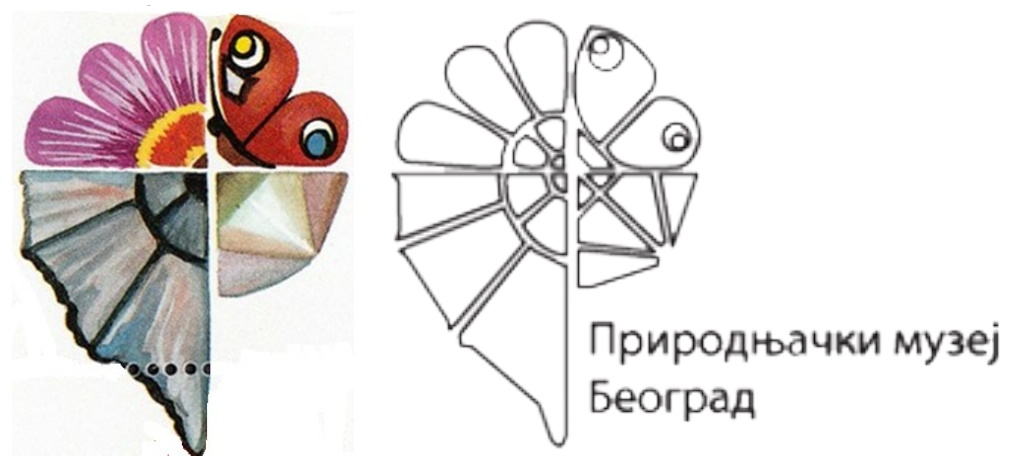 [A3] The logo of the Museum depicted on one of the labels from the middle of the sheet
"100th anniversary of the Natural History Museum in Belgrade".
[A3] The logo of the Museum depicted on one of the labels from the middle of the sheet
"100th anniversary of the Natural History Museum in Belgrade". The logo is combination of four elements: butterfly, flower, Ammonite and crystal.
It represents four major divisions of the museums: modern flora and fauna, paleontology and geology.
Unfortunately, all the issues in the 1996 set depicted insects and have no relevance to paleontology at all.
Commemorative covers and postcards of Yugoslavia related to Paleontology and Paleoanthropology: fossils of prehistoric animals and Neanderthal, paleontologists
| 25.10.1956 "100th anniversary of Dragutin Gorjanovic Kramberger, Croatian geologist and paleontologist" | 19.12.1959 "Centenary of the Origin of Species" | 23.08.1969 "70 years of discovery the Krapina prehistoric man" |
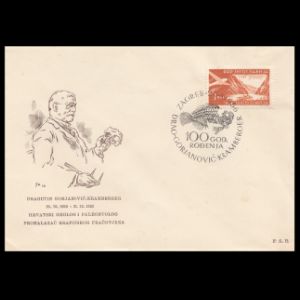 |
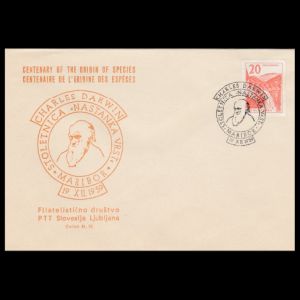 |
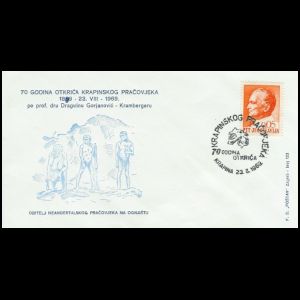 |
| 24.08.1986 "Europa'86 - Nature conservation " [Cov1] | 11.05.1991 "19th international mineral and fossil fair in Tržič " [Cov2] | |
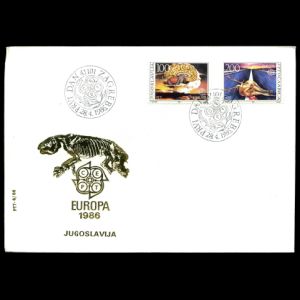 |
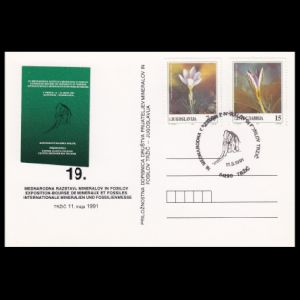 |
|
Notes:
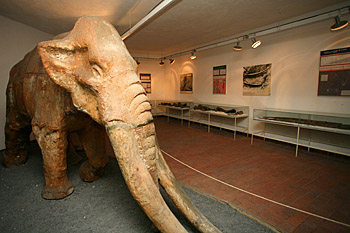 [Cov1] Illustration on
the FDC shows the giant ground Sloth, Megatherium shown on illustration of
the cover, perhaps as example of extinct animal. It is a bit odd that
fossil of an animal found only in South America was chosen for the FDC.
[Cov1] Illustration on
the FDC shows the giant ground Sloth, Megatherium shown on illustration of
the cover, perhaps as example of extinct animal. It is a bit odd that
fossil of an animal found only in South America was chosen for the FDC. [Cov2] Mastodont from Velenje (nowadays Slovenia) shown on illustration of the postcard. Fossil of the mastodon found near to the village in 1964 and is on exhibit at the local museum. |
Commemorative Postmarks of Yugoslavia related to Paleoanthropology: fossils and reconstruction of prehistoric animals, Neanderthal, Charles Darwin
Legend is here| 25.10.1956 "100th anniversary of Dragutin Gorjanovic Kramberger, Croatian geologist and paleontologist" | 19.12.1959 "Centenary of the Origin of Species" | 23.08.1969 "70 years of discoveryThe Krapina prehistoric man" |
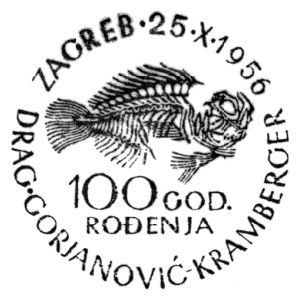 |
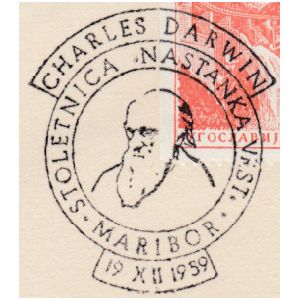 |
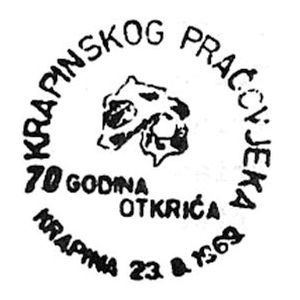 |
| 04.02.1985 "Fossils" [FDC] | 26.06.1991 "Ordovaca Cave" [PM1] | |
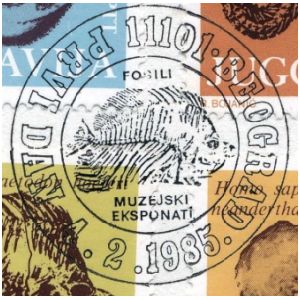 |
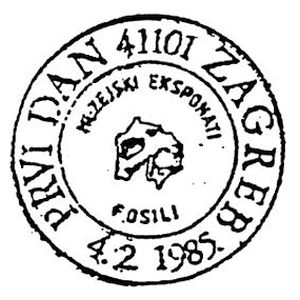 |
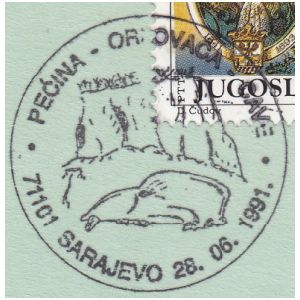 |
| 11.05.1991 "19th international mineral and fossil fair" | 27.12.1991 "The 100th anniversary of the foundation of the paleolithic research in Bosnia and Herzegovina" [PM2] | |
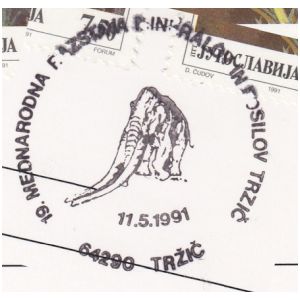 |
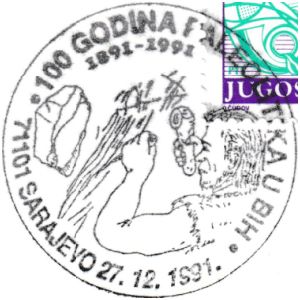 |
|
Notes:
[PM1] The skull of a cave bear in front of the Orlovača cave 20 km east of Sarajevo, today Bosnia and Herzegovina.
[PM2] A prehistoric man carving the petroglyphs of Badanj Cave and a stone tool shown on the left side of the postmark. The cancellation commemorates the 100th anniversary of the foundation of the paleolithic research in Bosnia and Herzegovina. The postmark was used at the Sarajevo post office.
[*] On 5th April 1992 the siege of Sarajwo began in the Bosnian war, that lasted nearly four years. 11,541 people lost their lives, including over 1,500 children. The house of the postmark's designer was completely destroyed including the cancellations and all documents, therefore the postmarks which were used in Sarajevo in 1991: PM1 & PM2 are very rare.
References:
- [R1] Yugoslavia: Wikipedia,
- [R2] Postal History and Philately of Jersey:
Wikipedia,
- [R3] Milutin Milanković: Wikipedia,
- [R4] Janez Vajkard Valvasor: Wikipedia.
Acknowledgements:
- Many thanks to fellow collector Peter Brandhuber from Germany who kindly shared many scans from his own collection and helped finding information about some commemorative postmarks of Yugoslavia.
- Many thanks to Dr. Peter Voice from Department of Geological and Environmental Sciences, Western Michigan University, for reviewing the draft page and his valuable comments.
| << previous country | back to index | next country >> |